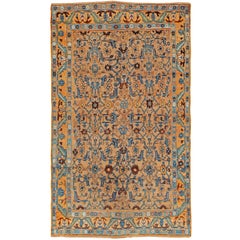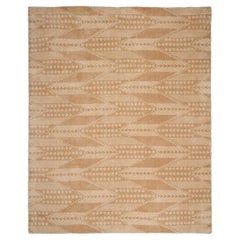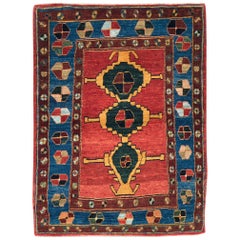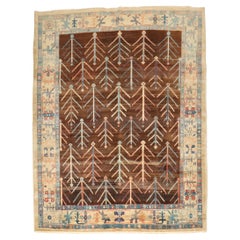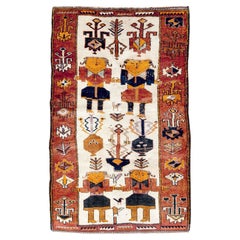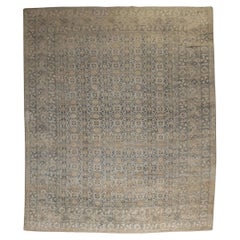New York City - More Carpets
to
761
Width
to
Length
to
3,977
1,265
61
740
230
127
79
66
62
42
21
21
20
12
11
2
2
2
44
483
3,450
1,326
1,355
1,262
156
56
44
106
63
30
62
44
34
8
5
5,223
4,911
387
287
36
5,303
23,219
3,397
5,303
4,994
5,102
4,570
3,454
2,080
1,374
1,244
155
120
64
46
38
Item Ships From: New York City
Early 20th Century Handmade Persian Kurd Throw Rug In Light Brown And Blue Green
Located in New York, NY
An antique tribal throw rug handmade by the Kurdish tribes of Persia during the early 20th century. An unusually large-scaled classic "Herati" pattern, for a small throw rug, over a ...
Category
Early 20th Century Persian Tribal New York City - More Carpets
Materials
Wool
Schumacher Fitzgerald 10' x 14' Rug In Natural
By Schumacher
Located in New York, NY
This rug will ship in December. Made with a wool-and-cotton jacquard weave, Fitzgerald is a large-scale zigzag pattern with unique chevron details and lovely texture. An adaptation o...
Category
21st Century and Contemporary American Modern New York City - More Carpets
Materials
Cotton
21st Century Handmade Persian Gabbeh Throw Rug
Located in New York, NY
A modern Persian Gabbeh throw rug handmade during the 21st century.
Measures: 3' 5" x 4' 7".
Category
21st Century and Contemporary Persian Tribal New York City - More Carpets
Materials
Wool
Zabihi Collection Persian Bakshaish Tree Square Intermediate Contemporary Rug
Located in New York, NY
A 21st Century copy of a Persian Bakshaish Tribal Rug
Details
rug no. j3235
size 6' 6" x 8' (198 x 244 cm)
Category
21st Century and Contemporary Persian Bakshaish New York City - More Carpets
Materials
Wool
Mid-20th Century Handmade Persian Pictorial Bakhtiari Accent Rug
Located in New York, NY
A vintage Persian pictorial Bakhtiari accent rug handmade during the mid-20th century.
Measures: 4' 8" x 7' 6".
Category
Mid-20th Century Persian Tribal New York City - More Carpets
Materials
Wool
Zabihi Collection Tribal Mini Khani Ersari Rug
Located in New York, NY
an early 20th century tribal ersari rug in green and brown with a mini khani pattern often found in 19th century caucasian rugs
Details
rug no. j3942
size 10' 3" x 12' 10" (312 x 39...
Category
Early 20th Century Afghan Tribal New York City - More Carpets
Materials
Wool
Mid-20th Century Handmade Persian Pictorial Bidjar Accent Rug
Located in New York, NY
A vintage Persian Bidjar accent rug handmade during the mid-20th century with a pictorial design.
Measures: 4' 7" x 6' 7".
Category
Mid-20th Century Persian Folk Art New York City - More Carpets
Materials
Wool
Galerie Shabab Collection Mid-20th Century Turkish Anatolian Room Size Carpet
Located in New York, NY
A vintage Turkish Anatolian room size carpet handmade during the mid-20th century.
Measures: 8' 6" x 10' 4".
Category
Mid-20th Century Turkish Rustic New York City - More Carpets
Materials
Wool
Mid-20th Century Handmade Turkish Flat-Weave Kilim Accent Carpet
Located in New York, NY
A vintage Turkish flat-weave Kilim accent carpet handmade during the mid-20th century.
Measures: 6' 10" x 9' 7"
Flat-weave rugs & carpets:
Knotted pile rugs are just one small part of a vast universe of textile techniques suitable for heavy use. If you can imagine it, some weaver has tried it out. Pieces can be roughly divided into those reversible from the start and those never, or at least not initially, reversible. Thus, kilims are considered reversible, while everything else is not.
Kilims are tapestry woven rugs with both sides the same, in either slit technique where colors change, or with various methods of avoiding slits. Slit tapestry weave goes back to ancient times and Coptic Egyptian weavers used it for ornaments on garments and larger wall hangings. Slits can be avoided by dovetailing of colors (warp sharing) or by interlocking the wefts. The Navajo weavers of the Southwest practice the first while the Fine shawl weavers of Kashmir and Kerman employed the second. Interlocking produces a one-faced fabric, with smooth and rough, ridged faces. The typical Turkish, Caucasian, or Persian rustic Kilim shows slits, but never long ones. Aubusson French carpets are also slit tapestries and the long color transitions are sewn up as part of the regular maintenance. Some kilims are very Fine. The best antique urban Sehna (Senna) kilims on wool, cotton or silk warps approximate the comparable rugs in refinement and are the most desirable of all Persian kilims. Although the various flatweave techniques are usually expressed in geometric, simple, often repeating, patterns, Sehna kilims demonstrate that even the most intricate designs can be effectively rendered in flat-stich. The term ‘Kilim’ has been extended to cover any pileless, weft-faced heavy textile. Thus, the sectioned and joined northeastern Persian horizontally striped wool rugs are called ‘kilims’. So are the plain-weave end finishes of pile rugs. All these are weft-faced, weft patterned flatweaves.
These sectioned pieces are woven not on a frame loom, but one steadied by the weaver at one end and with the warps fastened down at the other. Only relatively recent have these tribal pieces become available. They are used as floorcoverings, hangings, room dividers, furniture covers. They are mostly bitonal in shades of natural dark brown and beige. Some more recent pieces show weaver innovations with ikat and moire effects. Work proceeds quickly and a skilled weaver can complete a thirty foot strip in almost no time.
Wefts, the elements added as weaving progresses, play an essential part in what is a flatweave. The best-known example of an extra-weft, wrapping technique is on Caucasian and tribal Persian Soumaks, where a pattern weft wraps around the fixed warp, changing as weaving progresses. Soumaks can be large carpets, Kuba in the Caucasus, small bag faces (Caucasian and Persian Shah Savan saddle bags), or cover scatter rugs (Persian Afshars). The Soumak technique is fast, and a weaver can work much more quickly than tying knots. The left-over wefts are cut off on the back, so the front and back are initially different. As a Soumak on the floor gets used, these weft yarns wear away and the two sides converge although the exact texture remains distinct.
There are other ways of pattern by weft. Often on smaller tribal pieces, the pattern weft(s) is (are) part of the weft structure, moving in an out, and holding the whole thing together. These wefts can be complementary or added (supplementary), continuous across the flatweave or cut off as they travel unneeded across the verso. Supplementary weft flatweaves are often very compact and substantial. The nomadic Turkmen and Balouch tribes employ both supplementary and complementary weft techniques on their pieces. Supplementary wefts are often raised on the recto (front) while complementary wefts are flat to the surface. Tribal Kurds employ this extra-wefting technique. The Balouch of Pakistan use complementary wefts almost exclusively on their small woven paraphernalia like salt bags.
Flatweave techniques may be combined on a single piece. Afshar rugs employ plain-weave end strips, preceded by Soumak bands, with pile sections between. The large Bakhtiari saddlebags feature Soumak work, pile “islands” an areas of plain-weave. Qashqai rugs and kilims frequently displays checkerboard end strips in continuous, complementary wefting.
Another distinct flatweave type is the jajim (jijim, cecim) in which a pattern is added with colored wefts as the weaving of the plain-weave ground progresses. Here the wefts are discontinuous and the pattern stands proud from the voided ground. Often made in two pieces on narrow looms and edge-sewn together, these may have geometric patterns. The term ‘jajim’ also refers to the assembled warp-faced strip and stripe covers from the Shah Savan of northwest Persia, the pattern is defined by warps alone, usually in plain stripes, but sometimes in designs of ladders, snakes, human figures and various animals. Here the color changing warps are continuous. Most are wool, a few are silk. Better to call these something else.
Indian ‘Dhurries’ are all cotton kilims and ‘shatrangis’ employ wool wefts on cotton warps. Dhurries are slitless. The cotton texture is more appropriate to the humid and warm climate of the Indian subcontinent. Modern Dhurries...
Category
Mid-20th Century Turkish Tribal New York City - More Carpets
Materials
Wool
Tribal Mid-20th Century Handmade Persian Pictorial Gabbeh Accent Rug
Located in New York, NY
A vintage Persian Gabbeh tribal accent rug handmade during the mid-20th century with a pictorial design of a lion.
Measures: 4' 0" x 7' 0".
Category
Mid-20th Century Persian Tribal New York City - More Carpets
Materials
Wool
Mid-20th Century Handmade Persian Malayer Throw Rug In Grey & Brown
Located in New York, NY
A vintage Persian Malayer throw rug handmade during the mid-20th century in shades of grey and brown.
Measures: 3' 7" x 5' 5"
Persian Rugs & Carpets:
Persia (Iran) is a moderately ...
Category
Mid-20th Century Persian Rustic New York City - More Carpets
Materials
Wool
Antique East Turkestan Khotan Runner
Located in New York, NY
An early 20th century Khotan runner.
Category
Early 20th Century Turkestan New York City - More Carpets
Materials
Wool
White & Beige Contemporary Handmade Turkish Flatweave Kilim Room Size Carpet
Located in New York, NY
A contemporary Turkish flatweave Kilim large room size carpet handmade during the 21st century in shades of white and beige. This patchwork style rug consists of hand-weaving togethe...
Category
21st Century and Contemporary Turkish Modern New York City - More Carpets
Materials
Wool
Antique Oversized Persian Bakhtirari Geometric Rug. Size: 15 ft x 30 ft
Located in New York, NY
Beautiful Tribal Antique Oversized Persian Bakhtirari Rug, Country of Origin / Rug Type: Persian Rug, Circa Date: Late 19th Century. Size: 15 ft x 30 ft (4.57 m x 9.14 m)
A starkly intriguing large oversized tribal design covers the body of this antique Persian rug, featuring tilted diamonds centered with four-petaled flowers. Each of these blossoms, with four large leaves reaching for the compass points, nestles amid a collection of smaller flowers with the same simplified style, solid colors set off by narrow line-work. These diamond medallions form a network over the piece, connected by geometric embellishments in white, yellow and blue over a black background. This beautiful and impressive, antique Persian Bakhtiari rug, features a high contrast between these tones gives the piece a mesmerizing visual appeal, capturing the eye and leading it along angular paths. A set of pale borders encloses this space, the widest backed with the dusky blue and arrayed with exotic blossoms rendered with symmetry and artful, dark line-work. Narrow bars...
Category
Late 19th Century Persian Tribal Antique New York City - More Carpets
Materials
Wool
Zabihi Collection Persian Pictorial Animal Gabbeh Rug
Located in New York, NY
a mid-20th-century Persian Gabbeh with an apricot colored lion on an ivory colored ground
Details
rug no. j4470
size 3' 3" x 4' 6" (99 x 137 cm)
Category
Mid-20th Century Persian Folk Art New York City - More Carpets
Materials
Wool
Mid-20th Century Handmade Spanish Savonnerie-Style Runner Rug in Dark Blue
Located in New York, NY
A vintage Spanish rug in runner format in the style and technique of French Savonnerie rugs handmade during the mid-20th century. The design, in shades of gold decorating the dark bl...
Category
Mid-20th Century Spanish Art Deco New York City - More Carpets
Materials
Wool
Antique Persian Heriz Serapi Rug
Located in New York, NY
An exquisite large size ivory field antique oversize Persian Heriz Serapi rug.
Measures: 11'7'' x 18'9''.
Category
Early 20th Century Persian Bakshaish New York City - More Carpets
Materials
Wool
Decorative Antique Turkish Oushak Rug. 20 ft x 26 ft 6 in
Located in New York, NY
Oversized Decorative Antique Turkish Oushak Area Rug, Country of origin / rug type: Turkish rugs, Circa date: 1900. Size: 20 ft x 26 ft 6 in (6.1 m x 8.08 m)
Category
20th Century Turkish Oushak New York City - More Carpets
Materials
Wool
Mid-20th Century Handmade Turkish Anatolian Art Deco Style Runner
Located in New York, NY
A vintage Turkish Anatolian Art Deco style runner handmade during the mid-20th century.
Measures: 3' 0" x 8' 5".
Category
Mid-20th Century Turkish Art Deco New York City - More Carpets
Materials
Wool
Contemporary Transitional Decorative Bidjar Rug
By Nasiri
Located in New York, NY
Our contemporary Bidjar rugs are inspired from 16th century Islamic textiles. We adapted those centuries-old designs into more modern, decorative motif...
Category
2010s Pakistani Oushak New York City - More Carpets
Materials
Wool
Mid-20th Century Handmade Indian Lahore Large Room Size Carpet
Located in New York, NY
A vintage Indian Lahore large room size carpet handmade during the mid-20th century.
Measures: 13' 2" x 16' 1".
Category
Mid-20th Century Indian Victorian New York City - More Carpets
Materials
Wool
Schumacher Iconic Leopard 9' x 12' Rug In Brown
By Schumacher
Located in New York, NY
This rug will ship in December. A versatile and wildly chic hand-knotted design made of wool and cotton, Iconic Leopard features a dense, allover animal motif with fabulous dimension...
Category
21st Century and Contemporary American Modern New York City - More Carpets
Materials
Wool
Contemporary Handmade Turkish Flatweave Kilim Accent Rug
Located in New York, NY
A modern Turkish flatweave Kilim accent rug handmade during the 21st century.
Measures: 6' 8" x 9' 7".
Category
21st Century and Contemporary Turkish Modern New York City - More Carpets
Materials
Wool
Antique Serapi Persian Rug. Size: 9 ft 9 in x 12 ft
Located in New York, NY
Beautiful Room Size Ivory Antique Serapi Persian Rug, Country of Origin / Rug Type: Persian Rug, Circa Date: 1900. Size: 9 ft 9 in x 12 ft (2.97 m x 3.66 m).
Category
Early 20th Century Persian Heriz Serapi New York City - More Carpets
Materials
Wool
Antique English Needlepoint Rug. 8 ft 8 in x 10 ft 5 in
Located in New York, NY
Floral Antique English Needlepoint Rug, Country of origin: England, Circa date: 1920. Size: 8 ft 8 in x 10 ft 5 in (2.64 m x 3.17 m)
Category
20th Century English Other New York City - More Carpets
Materials
Wool
Modern Turkish Flat-Weave Room Size Rug
Located in New York, NY
A modern Turkish flat-woven Kilim room size rug from the 21st century.
Category
21st Century and Contemporary Turkish Kilim New York City - More Carpets
Materials
Wool
Contemporary Handmade Turkish Flatweave Kilim Accent Rug
Located in New York, NY
A contemporary Turkish flatweave Kilim accent rug handmade during the 21st century.
Measures: 5' 5" x 7' 6".
Category
21st Century and Contemporary Turkish Modern New York City - More Carpets
Materials
Wool
Mid-20th Century Handmade Persian Pictorial Bakhtiari Tribal Gallery Rug
Located in New York, NY
A vintage Persian pictorial gallery format rug handmade by the Bakhtiari tribe during the mid-20th century.
Measures: 4' 10" x 12' 6".
Category
Mid-20th Century Persian Tribal New York City - More Carpets
Materials
Wool
Vintage Turkish Anatolian Rug
Located in New York, NY
A vintage Turkish Anatolian carpet from the mid-20th century.
Measures: 5' 5" x 7' 9"
Category
1960s Turkish Modern Vintage New York City - More Carpets
Materials
Wool
cc-tapis Retreat Rug by Germans Ermičs
By cc-tapis, Germans Ermics
Located in Brooklyn, NY
Hand knotted in the cc-tapis atelier in Kathmandu, Nepal. The rug is made with a cotton weave and a Himalayan wool pile, coming from the areas surrounding the atelier. 125.000 indivi...
Category
21st Century and Contemporary Nepalese Modern New York City - More Carpets
Materials
Cotton
Antique European Irish Donegal Rug. 10 ft 1 in x 13 ft
Located in New York, NY
Antique European Irish Donegal Rug, Country of Origin: United Kingdom, Circa date: Turn of the 20th century. Size: 10 ft 1 in x 13 ft (3.07 m x 3.96 m)
Category
20th Century Irish Arts and Crafts New York City - More Carpets
Materials
Wool
Galerie Shabab Collection Mid-20th Century Turkish Tribal Room Size Carpet
Located in New York, NY
A vintage Turkish Anatolian tribal room size carpet handmade during the Mid-20th Century.
Measures: 9' 11" x 12' 10".
Category
Mid-20th Century Turkish Tribal New York City - More Carpets
Materials
Wool
Antique Persian Tabriz Room Size Rug
Located in New York, NY
An early 20th century Persian Tabriz, 9' x 12' room size rug. Since the 19th century, Iran started exporting artisan carpets around the world, especially to Europe. Artists used one ...
Category
20th Century Persian Rustic New York City - More Carpets
Materials
Wool
Early 20th Century Handmade Persian Malayer Runner
Located in New York, NY
An antique Persian Malayer rug in runner format handmade during the early 20th century.
Measures: 2' 0" x 14' 6"
Persian Rugs & Carpets:
Persia (Iran) is a moderately large co...
Category
Early 20th Century Persian Victorian New York City - More Carpets
Materials
Wool
Mid-20th Century Handmade Chinese Art Deco Throw Rug
Located in New York, NY
A vintage Chinese Art Deco throw rug handmade during the mid-20th century.
Measures: 2' 0" x 3' 10".
Category
Mid-20th Century Chinese Art Deco New York City - More Carpets
Materials
Wool
Antique Persian Serapi Rug. Size: 9 ft x 11 ft 6 in
Located in New York, NY
Antique Persian Serapi Rug, Country of origin / rug type: Persian rugs, Circa date: 1900. Size: 9 ft x 11 ft 6 in (2.74 m x 3.51 m)
Category
20th Century Persian Heriz Serapi New York City - More Carpets
Materials
Wool
Rustic Mid-20th Century Handmade Distressed Persian Shiraz Accent Rug
Located in New York, NY
A vintage Persian Shiraz accent rug with a rustic appeal and tribal design handmade during the mid-20th century. The rug has a textured, weathered and distressed, feel but the founda...
Category
Mid-20th Century Persian Rustic New York City - More Carpets
Materials
Wool
Mid-20th Century Handmade Persian Pictorial Bakhtiari Accent Rug
Located in New York, NY
A vintage Persian pictorial Bakhtiari accent rug handmade during the mid-20th century.
Measures: 5' 0" x 6' 10".
Category
Mid-20th Century Persian Tribal New York City - More Carpets
Materials
Wool
Early 20th Century Handmade Persian Malayer Runner
Located in New York, NY
An antique Persian Malayer rug in runner format handmade during the early 20th century.
Measures: 2' 9" x 11' 6"
Persian rugs & carpets:
Persia (Iran) is a moderately large co...
Category
Early 20th Century Persian Rustic New York City - More Carpets
Materials
Wool
Early 20th Century Handmade Persian Tabriz Small Room Size Carpet
Located in New York, NY
An antique Persian Tabriz small room size carpet handmade during the early 20th century with a field in warm earth tones and the border in slate and light...
Category
Early 20th Century Persian Victorian New York City - More Carpets
Materials
Wool
Rustic Early 20th Century Handmade Persian Mahal Room Size Carpet
Located in New York, NY
An antique Persian Mahal room size carpet handmade during the early 20th century in the rustic style.
Measures: 11'2" x 13'10".
Category
Early 20th Century Persian Rustic New York City - More Carpets
Materials
Wool
Beautiful Vibrant Antique Caucasian Kazak Sewan Rug 5'10" x 7'6"
Located in New York, NY
Antique Caucasian Kazak Sewan Rug, Country of Origin / Rug Type: Caucasian Rug, Circa date: 1850. Size: 5 ft 10 in x 7 ft 6 in (1.78 m x 2.29 m)
Category
19th Century Caucasian Tribal Antique New York City - More Carpets
Materials
Wool
Mid-20th Century Handmade Persian Malayer Throw Rug
Located in New York, NY
A vintage Persian Malayer throw rug handmade during the mid-20th century.
Measures: 3' 6" x 5' 8"
Persian rugs & carpets:
Persia (Iran) is a moderately large country with a ve...
Category
Mid-20th Century Persian Rustic New York City - More Carpets
Materials
Wool
Contemporary Handmade Turkish Flatweave Kilim Oversize Carpet
Located in New York, NY
A contemporary Turkish flatweave Kilim large oversize carpet handmade during the 21st century.
Measures: 16' 0" x 20' 8".
Category
21st Century and Contemporary Turkish Modern New York City - More Carpets
Materials
Wool
cc-tapis Bliss Ultimate Rug by Mae Engelgeer
By Mae Engelgeer, cc-tapis
Located in Brooklyn, NY
Hand knotted in the cc-tapis atelier in Kathmandu, Nepal. The rug is made with a cotton weave, Himalayan wool and silk pile coming from the areas surrounding the atelier. 125.000 ind...
Category
21st Century and Contemporary Nepalese Modern New York City - More Carpets
Materials
Cotton
Contemporary Handmade Turkish Flatweave Kilim Accent Rug in Black and Blue
Located in New York, NY
A modern Turkish flatweave Kilim accent rug handmade during the 21st century with a modern design in black and blue.
Measures: 6' 5" x 8' 8".
Category
21st Century and Contemporary Turkish Modern New York City - More Carpets
Materials
Wool
Mid-20th Century Handmade Persian Veece Small Room Size Carpet
Located in New York, NY
A vintage Persian Veece small room size carpet handmade during the mid-20th century.
Measures: 6' 10" x 10' 2".
Category
Mid-20th Century Persian Rustic New York City - More Carpets
Materials
Wool
Mid-20th Century Handmade Turkish Anatolian Throw Rug
Located in New York, NY
A vintage Turkish Anatolian throw rug handmade during the mid-20th century.
Measures: 3' 6" x 4' 11"
Turkish Rugs & Carpets:
Until the Great Persian Carpet Revival in the later 19th century, the “Oriental rug” was Turkish. For nearly six centuries, Turkish rugs, both scatter, room size, and even larger, thoroughly dominated the European import market. Whereas the Persian carpet can be divided into urban, village, and tribal types, in Turkey and its predecessor the Ottoman Empire, rugs almost exclusively came from village weavers and from a small number of urban workshops. Ninety percent village, nine percent city, one percent tribal.
Turkish weavers have, with very few exceptions, always worked with the symmetric (Turkish) knot. Wool foundations are standard practice among both town and village weavers. The exceptions, very finely woven 20th century and recent Herekeh silks from near Istanbul, and early 17th century Ottoman Court rugs from Bursa, constitute only a tiny part of the total. Always pricey, they appealed and still appeal to the clients who want lots of knots and perfect execution instead of individual personality.
The urban workshops have been centered around the western Turkish city of Oushak and its attendant port town of Smyrna. Oushak weaves with the trends in fashion. When color saturated medallion carpets were needed, Oushak was ready in the 17th and 18th centuries. When coarse red and blue carpets were required, Oushak and Smyrna in the 19th century wove them by the boatload. When tastes changed again, and the European dealers in Smyrna wanted room size carpets with lighter and unusual colors, and with Persianate designs, production ramped up in nearby Oushak. Those antique, all-wool construction turn-of-the-century carpets are still in high demand with designers. Antique carpets with allover, roughly drawn patterns on grounds of shrimp, rust, straw, cream, pale blue, and pale and pea green, hitherto unavailable colors, are in such demand today that contemporary Oushaks have attempted to mimic them with soft palettes, extra-large scale drawing and coarse weaves.
Oushaks woven for the Turkish market, for palaces, houses and mosques were often oversize with large, repeating medallions, all in shades of (Turkey) red, dark blue, light blue-teal, and ivory, with lemon and green accents. Turkey, along with India, invented standard sizes. By vertically repeating the medallion, one could get one medallion, one with two end halves, two, three, etc. medallions, up to thirty or so feet in length. The process spared making new cartoons for each length and allowed a quicker turnaround time. Oushak, from the time of 15th century “Holbein” rugs onward, has always been a commercial center.
The prayer niche directional rug is primarily a Turkish development. In the towns and villages east of Oushak, in Ghiordes, Kula, Ladik, Kirsehir, Mucur and Konya, among others, arch pattern scatters with bright palettes and weaves varying from relatively fine to moderate were almost the entire production. Antique examples were particularly popular in America around 1900.
Other centers of village weaving were situated on the western coast and adjacent islands with the town of Melas and neighboring villages weaving geometric prayer rugs and scatters with a characteristic khaki green and lots of yellow.
The other large region was in the northwest of Anatolia, near ancient Troy, with the sizable town of Bergama at its center. The satellite towns of Ezine, Karakecilli, Yuntdag, and Canakkale all wove colorful scatters with moderate weaves in all wool with geometric designs and cheerful palettes. Near to Istanbul, these were among the first Turkish rugs to reach Europe in the Renaissance.
The earliest Turkish pieces depicted in Italian Old Master paintings display the so-called “Memling gul”, an allover panel pattern with hooked and stepped elements within the reserves. This pattern continues for centuries in the Konya area and in the Caucasus as well.
Turkey is a land of villages and much of the most interesting Turkish weaving comes from one undiscovered village or another. The Konya-Cappadocia region of central Turkey includes the active towns of Karapinar, Karaman, Obruk, Sizma, and Tashpinar, all weaving Konya-esque scatters and long rugs. Karapinar has been active the longest, since the 17th century. The mosques in and around Konya have preserved locally-made rugs from the fourteenth. In the 20th century, the extra-long pile, many wefted Tulu rug was devised, with limited palettes and color block patterns. These are not really antique Tulus, but they must be a product of long-standing village tradition.
There are thousands upon thousands of rural Turkish villages, almost all with easy access to local tribal wool. Rug students are discovering new names and rug types almost daily. The common denominators are bright colors, geometric designs, wool construction, moderate to coarse weaves and symmetric knots. Synthetic dyes hit the Turkish rug industry quickly and hard after 1870, and they penetrated to even the most off-the-beaten-track villages. This development was almost entirely negative. The village weavers used fugitive or overly bright dyes which ruined the color harmonies built up over centuries. Characteristic types disappeared or were negatively transmuted. The Turkish village rug of the 1870 to 1920 period is nothing to be proud of.
In the eastern provinces, the semi-nomadic Kurdish tribes, collectively called ‘Yuruks’, weave all wool, geometric pieces with medium to medium-coarse weaves, as well as kilims and other flatweaves. The rugs employ cochineal instead of madder for the reds, mustard yellows, greens, and various blues. They are under-collected like the Persian Afshars. Their rugs are in scatter and long rug formats. The far eastern Turkish town of Erzerum has a long tradition of idiosyncratic, semi-workshop rugs and further to the east is Kars with a tradition of rugs in the Caucasian Kazak manner.
One Turkish specialty is the Yastiks or cushion cover, made in pairs for the public living rooms of village houses. These are larger rugs in miniature and good ones are highly collectible. Like other Turkish rustic weavings, ones with synthetic dyes are almost totally undesirable. Only the tribal Baluch make similar cushion covers, known as pushtis or balishts, in the same small, oblong format. Yastiks always have a back, usually in plain weave, so that they can be easily stuffed.
When the Imperial Carpet Factory at Herekeh near Istanbul closed in the early 20th century, the highly proficient Armenian master weavers set up in the Kum Kapi district of Istanbul where they wove all-silk, exquisitely fine and elaborately detailed small pieces, sometimes enriched with metal thread, for the most discriminating European buyers. Today the best, signed Kum Kapi pieces, usually in the “Sultan’s head” prayer niche design, can fetch upwards of $100,000. They are strictly for the wall. An Interwar all-silk room size Kum Kapi carpet is both exceedingly rare and stratospherically priced. The workshops closed in the 1930s, but the weaving of extremely fine, all-silk small rugs in Herekeh was revived in the 1960s.
There has been a recent vogue for larger Turkish village vintage...
Category
Mid-20th Century Turkish Rustic New York City - More Carpets
Materials
Wool
Early 20th Century Persian Sultanabad Room Size Carpet In Light Blue and Beige
Located in New York, NY
An antique Persian Sultanabad room size carpet handmade during the early 20th century with a light blue field and beige border.
Measures: 8' 11" x 11' 8".
Category
Early 20th Century Persian Sultanabad New York City - More Carpets
Materials
Wool
Zabihi Collection Persian Malayer Accent Size Rug
Located in New York, NY
1910s Persian Malayer Rug
Details
rug no. j3907
size 4' x 6' (122 x 183 cm)
Category
20th Century Persian Tabriz New York City - More Carpets
Materials
Wool
Galerie Shabab Collection Mid-20th Century Chinese Art Deco Room Size Carpet
Located in New York, NY
A vintage Chinese Art Deco room size carpet handmade during the Mid-20th Century.
Measures: 8' 11" x 11' 7".
Category
Mid-20th Century Chinese Art Deco New York City - More Carpets
Materials
Wool
Mid-Century Modern Rug in White and Black Square Rug Pattern by Rug & Kilim
By Rug & Kilim
Located in Long Island City, NY
Made with unique blend of hand knotted New Zealand wool, all natural silk, and exotic proprietary yarns as a 4 x 4 square rug, this Mid-Century Modern rug hails from the latest addit...
Category
2010s Indian Mid-Century Modern New York City - More Carpets
Materials
Wool
Contemporary Handmade Persian Flat-Weave Kilim Accent Rug
Located in New York, NY
A modern Persian flat-weave Kilim accent rug handmade during the 21st century.
Measures: 3' 5" x 6' 8"
Flat-weave rugs & carpets:
Knotted pile rugs are just one small part of a vast universe of textile techniques suitable for heavy use. If you can imagine it, some weaver has tried it out. Pieces can be roughly divided into those reversible from the start and those never, or at least not initially, reversible. Thus, kilims are considered reversible, while everything else is not.
Kilims are tapestry woven rugs with both sides the same, in either slit technique where colors change, or with various methods of avoiding slits. Slit tapestry weave goes back to ancient times and Coptic Egyptian...
Category
21st Century and Contemporary Persian Modern New York City - More Carpets
Materials
Wool
cc-tapis Pure New Forêt Rug by cc-tapis Design-Lab
By cc-tapis, cc-tapis design lab
Located in Brooklyn, NY
Hand knotted in the cc-tapis atelier in Kathmandu, Nepal. The rug is made with a cotton weave, a Himalayan wool and pure silk, coming from the areas surrounding the atelier. 152.000 ...
Category
21st Century and Contemporary Nepalese Modern New York City - More Carpets
Materials
Cotton
Mid-20th Century, Handmade Persian Heriz Accent Rug
Located in New York, NY
A vintage Persian Heriz accent rug handmade during the mid-20th century.
Measures: 6' 7" x 9' 4".
Category
Mid-20th Century Persian Rustic New York City - More Carpets
Materials
Wool
Contemporary Handmade Turkish Flat-Weave Kilim Large Geometric Room Size Carpet
Located in New York, NY
A modern Turkish flat-weave Kilim large room size carpet handmade during the 21st century with a colorful geometric pattern resembling interconnected serrated edged vases in an abstr...
Category
21st Century and Contemporary Turkish Modern New York City - More Carpets
Materials
Wool
Magnificent Blue Antique Persian Sarouk Area Rug 11'2" x 12'6"
Located in New York, NY
Magnificent Blue Antique Persian Sarouk Area Rug, Country of origin: Persian Rugs, Circa date: 1920
Category
20th Century Persian Sarouk Farahan New York City - More Carpets
Materials
Wool
Contemporary Handmade Turkish Flat-Weave Kilim Colorful Room Size Carpet
Located in New York, NY
A modern Turkish flat-weave Kilim room size rug handmade during the 21st century with a colorful horizontally striped pattern. A statement piece with its bright and whimsical colors....
Category
21st Century and Contemporary Turkish Modern New York City - More Carpets
Materials
Wool
